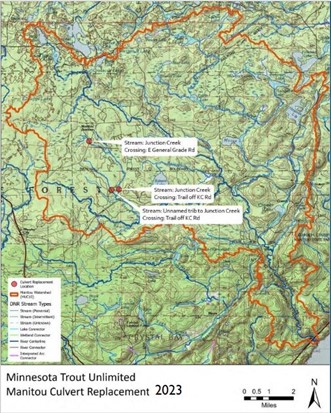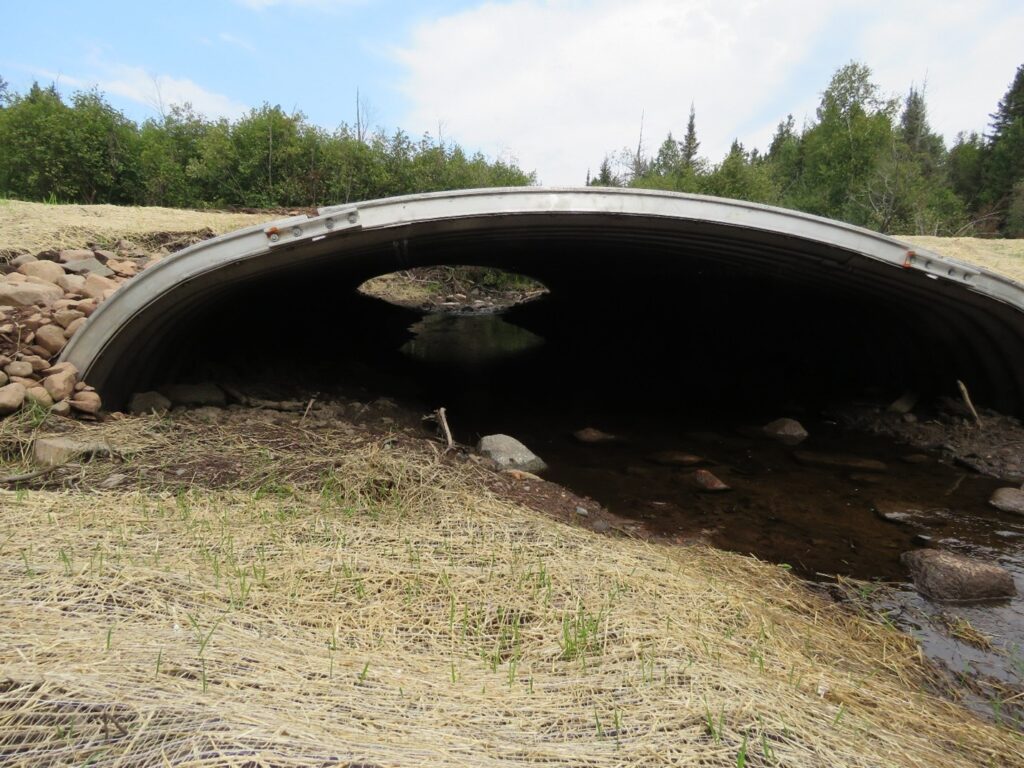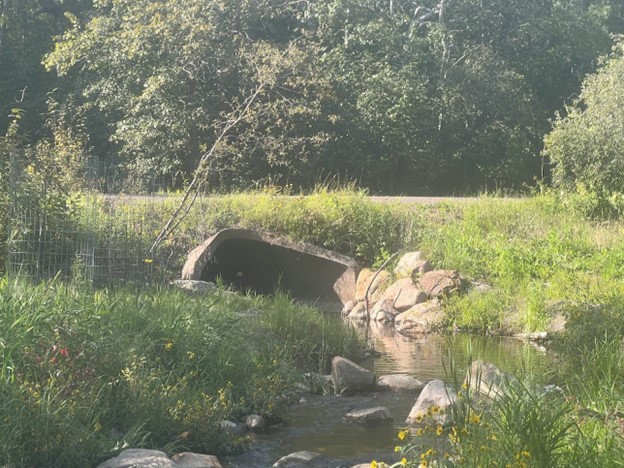Flowing Freely: Minnesota’s Culvert Comeback
for Restoring Fish Passage
When it comes to the movement of stream-dwelling fish, it’s easy to forget that unobstructed pathways are vital for their natural behaviors, allowing them to navigate seamlessly through waterways, reach essential spawning and overwintering areas, and access abundant feeding grounds. The absence of barriers ensures the fluidity of their life cycles, contributing to thriving fish populations and the overall health of aquatic ecosystems.
So What Gets in the Way?
Barriers to fish movement come in a variety of natural and unnatural forms. Some barriers, like waterfalls, occur naturally because of local geological conditions, whereas others, like dams, road crossings, and culverts, exist to meet human demands for the development of roads and transportation. Many of these structures were put into place during a rapid expansion of infrastructure needs in the last century, and without concern for potential ecological consequences.
Today, removing unnatural fish barriers in northeast Minnesota streams is a critical concern due to the profound impact these structures have on the health of riparian ecosystems. Minnesota streams are home to various fish species, including native Brook Trout Salvelinus fontinalus, and barriers, like poorly designed culverts, impede the natural movement of these populations. This restriction disrupts essential migratory routes, limiting access to spawning, overwintering, and feeding grounds, while diminishing habitat for macroinvertebrates and other nongame organisms.
The concern over poorly designed culverts goes beyond individual fish species; it extends to the overall health of the entire river ecosystem, including connectivity, biology, geomorphology, water quality, and hydrology.
Connectivity
Improperly sized or sloped culverts have the potential to sever the crucial link between the stream and its floodplain, disrupting the natural flow of the ecosystem, while also acting as barrier to longitudinal fish passage, impeding the migratory routes of aquatic species. This obstruction not only hinders the natural movement of fish but also disrupts the ecological balance within the waterways.
In the diagram of the recent culvert replacement on Tischer Creek, note how a too-narrow culvert can generate a fast-moving current which fish cannot swim against, or a waterfall at the outlet that is too difficult for fish and invertebrates to jump. A properly sized culvert has a width and slope that aligns with the upstream and downstream dimensions of the channel, allowing fish and other organisms to pass unrestrictedly. In northeastern Minnesota streams, such passage is crucial for allowing trout to access spawning and seasonal habitat (cold water in the summer and open water for overwintering).
Biology
The impact of improperly designed culverts extends to the biology of how streams and fish populations function. Many fish and invertebrate species depend on expansive, connected river habitats to complete their life cycles seamlessly. When culverts disrupt this continuity, it poses a significant threat to the ecological balance. Notably, the reproductive segregation caused by culverts can cause long-term genetic changes in populations by impeding the natural flow and connectivity of rivers, limiting gene flow and potentially leading to genetic divergence.
Beyond genetics, the consequences of culverts extend to increased sedimentation. Altered flow patterns caused by poorly designed culverts contribute to higher sediment loads, posing a risk of burying the gravel riffles that offer critical trout spawning habitat and provide homes for a diversity of macroinvertebrates.
In diagram, the “before” culvert lacks the appropriate gravel and cobble substrate to allow for fish and macroinvertebrates to feel “at home” when passing through, while the “after” culvert passes water sediments naturally, while offering substrates that mimic the natural streambed. Addressing the impact of culverts on stream biology is crucial for preserving the intricate web of life that relies on the interconnectedness of river habitats.
Geomorphology
Stream geomorphology is the scientific study of the physical characteristics, formations, and dynamic processes shaping the channels of streams and rivers, encompassing the interactions between water, sediment, and the surrounding landscape.
The repercussions of poorly designed culverts on the geomorphology of streams delve into critical alterations in the natural landscape. First, culverts disrupt natural sediment flow regimes within streams, acting as barriers that impede the normal movement of sediments. This disturbance not only affects the physical structure of the streambed but also has broader ecological consequences by influencing sediment-dependent processes crucial for the health of the aquatic environment. For example, in the diagram, you can see that the narrow culvert constricted stream flow and caused water to pond upstream, causing sedimentation above the culvert.
Second, altered flow patterns created by these poorly designed culverts contribute to increased erosion along the streambanks and bed. This erosion can lead to a loss of soil, vegetation, and overall habitat stability, further exacerbating the environmental impact.
Moreover, the installation of culverts can result in the shortening of rivers and alterations in river slope. These changes, while seemingly localized, can have far-reaching consequences on the entire river network, affecting sediment transport, habitat availability, and the overall geomorphic equilibrium of the stream. Addressing the impact of poorly designed culverts on stream geomorphology is crucial for preserving the integrity of these natural systems.
Water Quality
The adverse effects of poorly designed culverts extend to the water quality of streams, introducing challenges that impact the delicate balance of aquatic ecosystems. First, these culverts contribute to increased turbidity (or cloudiness) of the water by altering flow patterns in ways that lead to disturbed sediment. This rise in turbidity has cascading effects, affecting light penetration, and disrupting the ecological processes dependent on clear water, including the photosynthetic activity of algae and aquatic plants.
Second, the phenomenon of “backwatering” behind improperly sized culverts poses a threat to water quality. This process results in an extended residence time of water, allowing it to absorb more solar energy. Consequently, higher water temperatures become a concern, potentially reaching levels detrimental to aquatic life.
Hydrology
The influence of poorly designed culverts on stream hydrology is intricately tied to alterations in both velocity and water depth. Culverts, when inadequately sized or designed, act as bottlenecks in the stream channel, leading to changes in flow regimes. The constriction caused by these suboptimal culverts often results in increased stream velocities as water is forced through a narrower opening, disrupting the natural balance of flow. This elevated velocity can lead to erosion of the streambed and streambanks, causing downstream consequences for sediment transport and habitat stability.
Simultaneously, these improperly designed culverts can also impact water depth. The constriction of the channel may lead to fluctuations in water depth, creating uneven conditions along the stream. This variation in water depth can adversely affect aquatic habitats, particularly those species that are sensitive to changes in water levels. The interconnected relationship between stream velocity and water depth underscores the importance of well-designed culverts in maintaining the hydrological integrity of streams and supporting the diverse ecosystems they harbor.

By leading efforts to remove fish barriers in northeast Minnesota, MNTU aims to restore the connectivity of streams, promoting the natural flow of water and facilitating the movement of fish populations. This initiative is essential for preserving the integrity of aquatic ecosystems, supporting diverse fish species, and maintaining the overall ecological balance in the region.
Prioritizing Culvert Replacements Based on Fish Passage
For the past several years MNTU has worked with MNDNR Fisheries, the local Soil & Water Conservation Districts, local highway departments, and other partners to replace the worst culverts which block brook trout passage. Given the vast number of culverts across the northeast region of the state, selecting which culverts to replace was done using a systematic approach using the MN DNR culvert assessment protocol, which evaluates culverts based on fish passage requirements, including:
- Perch of the outlet
- Size of culvert relative to bankfull width
- Presence of substrate within the culvert
- Alignment of the culvert with natural stream pattern
Once problematic culverts have been identified, MNTU uses stream temperature and fish population data from the MN DNR to select which culverts to select for replacement, prioritizing those with the best potential to expand connectivity of suitable habitat for local brook trout populations.
MNTU Culvert Replacements Completed in 2023
Using Lessard Sam Outdoor Heritage Funds, MNTU replaced three culverts in the Manitou River watershed during the summer of 2023, including two on Junction Creek and one in a tributary.


Locations of culverts replaced for fish passage in the Manitou River watershed in 2023. Pictured here is a perched, undersized culvert on Junction Creek at KC Trail crossing in the Manitou River watershed.
The culverts were undersized and perched, and lacked suitable substrate for fish and macroinvertebrates.

New culvert on Junction Creek at KC Trail crossing in the Manitou River watershed.
MNTU Culvert Replacements in 2024
The MNDNR has identified 55 problem crossings in the Baptism River watershed. Following a comprehensive review of the of these barriers, MNTU has identified two culvert replacements in the Baptism River watershed to be designed and constructed in 2024.
In addition, a culvert on Keene Creek, located between in stream habitat projects completed in 2021 and 2022, will be constructed in 2024.

Culvert to be replaced in 2024 on Keene Creek in Hermantown.
Recent research on north shore brook trout shows that long range movement is common, and that wild brook trout often move considerable distances in the summer to reach thermal refuges of cold water. As climate change continues to alter stream flows and temperatures, restoring access to suitable habitat is a critical step in protecting and sustaining brook trout populations across northeast Minnesota.
